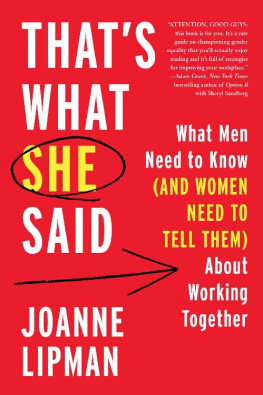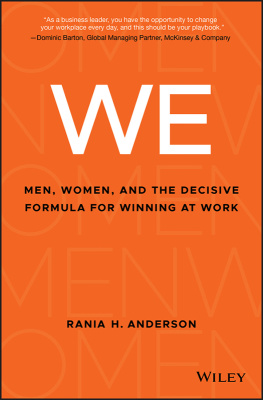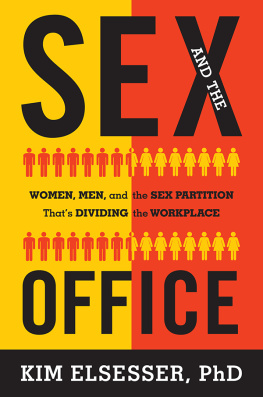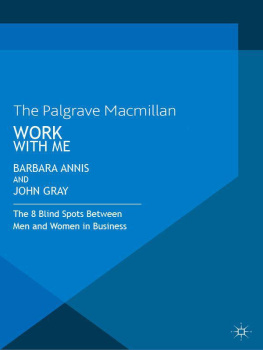I am profoundly grateful to all of those who shared their stories, advice, research, and time. Your generosity animates every chapter.
At William Morrow, my appreciation knows no bounds. Thanks to publisher Liate Stehlik and to extraordinary editor Rachel Kahan, whose every suggestion improved this manuscript (and we made it to the finish line before your due date!). Huge thanks to Sharyn Rosenblum, Lynn Grady, Molly Waxman, and Alivia Lopez, for championing this book every step of the way. Julia Meltzer, Nyamekye Waliyaya, and copy editor Karen Richardson saved me from myself more times than I can count. My thanks as well to Henry Ferris, who advocated for this book from the start.
This book wouldnt have happened without the inimitable Suzanne Gluck, who pushed me during the proposal phase, encouraged me during its gestation, and offered valuable feedback when the manuscript was done. Shes also a great friend and kick-ass #momboss who leads the way for all of us. Thanks as well to Matilda Forbes Watson, Janine Kamouh, Lauren Szurgot, and Andrea Blatt.
For her assistance as we sprinted toward the deadline, journalist Michelle Higgins has my eternal gratitude (and lifetime pool privileges for Veloria!). Thanks as well to researchers/fact-checkers Kevin Millian, Taylor Hess, and Nicole Gimple.
During the course of writing this book, I joined Gannett and the USA Today network. My colleagues inspire me every day with their talent, dedication, and creativity. I am grateful to so many of you whose insights inform this book and whose support I treasure, includingbut not limited to!early readers Barbara Wall, Brent Jones, and Keira Nothaft, as well as Chrissy Terrell and Markus Williams.
Huge thanks to Roger McNamee for his enormously valuable feedback on the manuscript. My gratitude as well to others who read part or all of early drafts and improved it at every turn, including Sheryl Sandberg, Ragini Verma, Andrew Tisch, Adam Grant, Sallie Krawchek, Katie Couric, Charles Duhigg, Matt Krentz, Melanie Kupchynskey, and Glen Mazzara. My appreciation to Maggie Kneip and Courtney Hamilton for their excellent counsel. And special thanks to my forever-roomie Carol OKeefe for her wisdom, candor, and friendship.
Finally, I thank my family: My late father, Burton Lipman, and my mom, Diane Lipman, for raising three strong daughters, who in turn have raised two more generations of equally strong and compassionate daughters and sons (and sons-in-law!). To my own kids, Rebecca and Andrew, who are an inspiration to me daily. And to my husband, Tom, who not only lived with this book for three years; he has lived the book his whole life, as a champion of women in general and me in particular. My love for you is infinite.
The scores of men and women I interviewed have come up with multiple strategies to level the gender playing field. Here are a few that any one of us, male or female, can adopt:
- Interrupt the interrupters.
Even female Supreme Court justices are interrupted three times more frequently than male justices. As powerful as these women are, they are just like other women, Northwestern University researchers wrote, talked over by their male colleagues. Solution: Institute a no interruptions rule for everyone, as The Walking Dead producer Glen Mazzara does. Alternatively, if a woman is cut off in conversation, cut off the interruptor: Olivia was speaking. Lets let her finish her thought first.
- Use amplification and brag buddies.
Womens ideas often arent hearduntil they are repeated by a man, who gets the credit. Solution: Take a cue from the women of the Obama administration and amplify the original speaker, by repeating her idea and ensuring that she is recognized for it. Whats more, since women are penalized if they talk about their accomplishments, they (along with simpatico men) can become each others brag buddies. They can share each others accomplishments with one another, and then each tout the others achievements.
- Diversify the interviewers, not just the applicants.
More companies are adopting a Rooney Rule for the office, requiring a diverse slate of applicants for job openings. But bringing in female applicants is only a first step. If the interviewers arent diverseif, say, all the interviewers are white menthey are less likely to see her as a cultural fit, while she may feel so uncomfortable that she rejects the job even if offered. Solution: Mix things up. Expand that Rooney rule to the interviewers too: ensure that not only the slate of candidates, but the interviewers are diverse.
- Shell help your bottom line.
Women are often boxed out of jobs or promotions because they arent a good fit, or they are dismissed as diversity hires who are a sign of lowered standards. Solution: Marshal the facts. Adding women makes work groups more creative. Companies with female chief financial officers make fewer, better acquisitions than those with male chief financial officers. Firms with the most female board members outperform those with the least by almost every financial measure. Mixed groups can even solve a murder more accurately than single-sex groups. Want a recipe for success? Simply add women.
- Shes not sorry, shes not lucky, and shes not asking you a question.
Researchers have found that women often use qualifiers (Sorry to bother you, but...) to make themselves less threatening to others. If they do act assertively, they are penalized for it, considered bossy, bitchy, or difficult to work with. Solution: Women are highly aware of these verbal ticks and try to control them themselves. But if they dont, just remember the next time a woman ends a sentence in a question-mark upspeak, imagine she is instead stating it as a fact and banging on the table.
- Yeah, thats not a compliment.
Women are often subjected to compliments that, intentionally or not, belittle themlike when I spent hours preparing for a television news interview, only to be told by a senior executive that I looked cute. Solution: Would you say that to a man? If not, you probably should not say it to a woman, either.
- Shes pretty sure you dont respect her.
Researchers have found that men get more respect than womeneven if they hold the exact same position. Solution: Be on the lookout for slights large and small, and adjust your own behavior. When you meet a couple, do you ask the man about his work but ignore the woman? Do you listen to a man in a meeting, but look at your email when a woman speaks? That vigilance goes for all of us, myself included. In an early draft of this book, I unwittingly referred to a female doctor by her first name, but a male physician by the honorific doctor. Turns out that this is a common slight, researchers have found. Not a mistake Ill make again.
- Dont decide for her.
When a new opportunity comes up, Ive often heard senior executives say that Mia would be ideal, but she has a new baby at home and wouldnt want to travel... or she has young kids and wouldnt want to relocate... or she wouldnt want to take on the extra hours. Solution: Dont assume. Ask her. Even if she declines, present the next opportunity, and the one after that. My own bosses did that for me when my children were youngand as result, when I was ready to rev up my career they were there, still offering me opportunities.
- Dont be afraid of tears.
Barbara Annis and John Gray, coauthors of the book Work with Me: The 8 Blind Spots Between Men and Women in Business, identify emotion as one of the major pitfalls men face. Fear of tears can lead male managers to hold back from giving women the honest feedback they need to progress.







